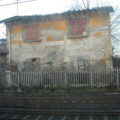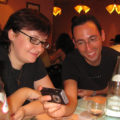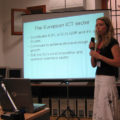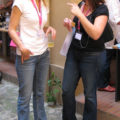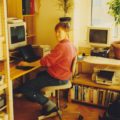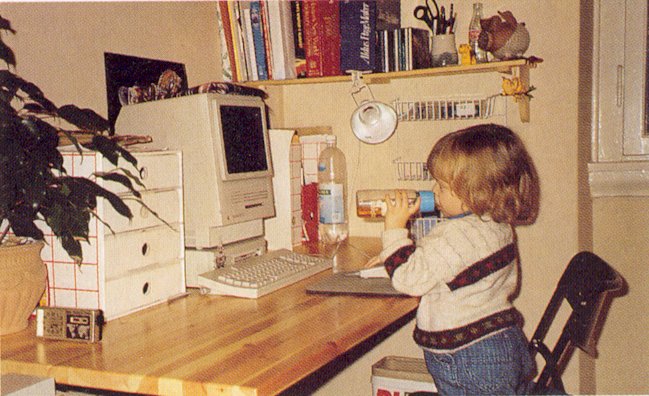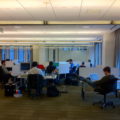Soon after we moved to Italy in December, 1990, I read an article in Italia Publishers, a magazine about desktop publishing, in which the writer described his difficulties in finding a font for Hindi. Although he had never been to India, he had been studying the language in Milan for fun, and wanted to write the world’s first Hindi-Italian dictionary. “Well,” I thought, “I’m one of the few people in the world qualified to help him: I speak Hindi and Italian, and I know a lot about desktop publishing.” So I wrote him a letter, care of the magazine, proposing to collaborate on the project.
After a few weeks, the writer called me. The dictionary project had never taken off; he couldn’t find a publisher. “But the magazine editor wants to speak with you,” he said. There was a shortage of journalists who could write about computers, and they were willing to try me out. My first piece was a small review of a piece of Macintosh software, I don’t remember the name, it was an organizer/calendar with “personalities” that would talk to you. The editor of Applicando, then the leading Italian Mac magazine, liked this piece, and more work flowed in from him and other magazines in the same publishing stable.
Another early piece was about “The Manhole,” kids’ software for the Macintosh which was more a world to explore than a game. We tested it on Rossella, then only two years old, who had no trouble picking up the concepts of the mouse and pointer. The review included a photo of her in front of the Mac, intent on the screen, with the mouse in one hand and her bottle in the other. NB: The guys who did “The Manhole” later on went on to do Myst.
The writing didn’t pay well, but there were perks. I got to go to Edinburgh on a junket paid by Aldus (the company that created PageMaker desktop publishing software). All I had to do was write an article about their new product announcements. I helped pay a couple of trips to Boston by writing articles about the Seybold Conference, to which I got free entrance as an accredited journalist (though I was badly snubbed by a “real” computer journalist I had idolized, Denise Caruso). And I got into the Microsoft CD-ROM Conference in San Jose the same way; by then, Fabrizio and I were going to the conference for other reasons as well.
One of the CD-ROM conferences I attended took place in the “porno year.” This was when conference organizers in the US finally decided to admit that pornography was a driving force in software and CD-ROM publishing (as it would later be for the Internet), and to allow the porn merchants to attend on almost the same footing as other publishers. There was a whole floor devoted to porn at the big Comdex show in Las Vegas, but I didn’t go to that. The situation at the CD-ROM conference was funny. The pornies had a section of the floor to themselves, carefully draped off with black curtains. There was also a conference session on pornography, held at 9:00 in the evening, well apart from every other session.
Fabrizio was amused by all this. His first big foray into CD-ROM publishing had been “The CD-ROM Unabashed History of Photographic Erotica,” co-edited with a photo archive in Milan, which he had tried to advertise at the conference several years before. He’d been forced to take down his posters, but word got around anyway – back in Milan, Microsoft ordered two copies for somebody high up in the company.
I looked at some of the porno stuff at the conference, brought back lots of samples, and wrote a wry, amused piece about the American reaction to it all. Nino, the magazine editor, was thrilled to include pictures of the products: “Finally, we have tits – just like Panorama and L’Espresso!” (Two Italian news weeklies which often find ways to work naked women into their covers.)
My article also reported on the results of a “test” I had run at the office, where I got the engineering staff and my husband to watch a porn movie on CD with me. The engineers were intrigued by the fact that the disc was “hybrid” – it would run on both Macintosh and PC systems, a technological trick which the porn publishers pioneered. Everyone commented wisely on the jerkiness of the video, although, given the subject matter, perhaps some jerkiness was to be expected.
The American press had noticed the sudden “legitimization” of digital porn, and had a lot to say about it. Stephen Levy, author of “Hackers,” published in MacWorld an interview with a young porn CD publisher, which I happened to read while on a visit to the US.
Levy asked the publisher what his parents thought of his business. “My dad’s okay with it, but my mom’s not too thrilled,” was the reply. “Well, so-and-so,” concluded Levy sententiously, “you should have listened to your mother.” I was infuriated by Levy’s condescending tone towards his interviewee, especially in light of “Hackers,” where he notes that many computer geeks are lonely young men unable to get dates. It seems to me that digital porn is a sevice to those guys.
Not having a computer available, I scrawled off a furious note in my terrible handwriting, and sent it to MacWorld. Months later, at the SMAU computer show in Milan, I ran into a magazine editor I knew. “Hey, I saw your piece in MacWorld!” he said excitedly. They had published the letter, but since I was not a regular reader of MacWorld I hadn’t noticed. I’ll have to go dig that up someday to remember what exactly I wrote to Stephen Levy. I don’t know whether he ever replied.

